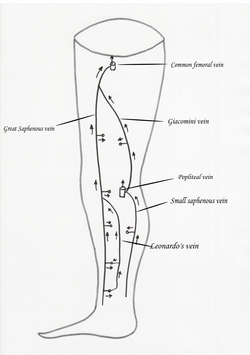| Giacomini vein | |
|---|---|
 Giacomini vein | |
| Details | |
| Drains to | great saphenous vein |
| Identifiers | |
| Latin | extensio cranialis venae saphenae parvae |
| Anatomical terminology | |
The Giacomini vein or cranial extension of the small saphenous vein [1] is a communicating vein between the great saphenous vein (GSV) and the small saphenous vein (SSV). It is named after the Italian anatomist Carlo Giacomini (1840–1898). The Giacomini vein courses the posterior thigh as either a trunk projection, or tributary of the SSV. In one study it was found in over two-thirds of limbs.[2] Another study in India found the vein to be present in 92% of those examined.[3] It is located under the superficial fascia and its insufficiency seemed of little importance in the majority of patients with varicose disease, but the use of ultrasonography has highlighted a new significance of this vein.[4] It can be part of a draining variant of the SSV which continues on to reach the GSV at the proximal third of the thigh instead of draining into the popliteal vein. The direction of its flow is usually anterograde (the physiological direction) but it can be retrograde when this vein acts as a bypass from an insufficient GSV to SSV to call on this last one to collaborate in draining. Many discussions exist about this vein, some of them confusing to a non-expert reader.[5] Insufficiency in the Giacomini vein can present in isolation but is mostly seen together with a GSV insufficiency. It has been shown to be effectively treated either with endovenous laser ablation or by ultrasound guided sclerotherapy.[6]
- ^ Kupinski, Ann Marie (July 2019). "Venous Nomenclature". Journal of Diagnostic Medical Sonography. 35 (4): 352–353. doi:10.1177/8756479319836983. S2CID 202165116.
- ^ Pourandokht Khodabakhsh, Konstantinos T. Delis; Alison L. Knaggs (December 2004). "Prevalence, anatomic patterns, valvular competence, and clinical significance of the Giacomini vein". Journal of Vascular Surgery. 40 (6): 1174–1183. doi:10.1016/j.jvs.2004.09.019. PMID 15622372.
- ^ Prakash, Kumari J; Nishanth Reddy, N; Kalyani Rao, P; Preethi Ramya, T; Singh, G (2008). "A review of literature along with a cadaveric study of the prevalence of the Giacomini vein (the thigh extension of the small saphenous vein) in the Indian population". Rom J Morphol Embryol. 49 (4): 537–9. PMID 19050803.
- ^ Georgiev M; Myers KA; Belcaro G (September 2001). "Giacomini's observations on the superficial veins of the abdominal limb and principally the external saphenous". International Angiology. 20 (3): 225–233. PMID 11573057.
- ^ Escribano, J.M. (July 2005). "Haemodynamic Strategy for Treatment of Diastolic Anterograde Giacomini Varicose Veins". European Journal of Vascular and Endovascular Surgery. 30 (1): 96–101. doi:10.1016/j.ejvs.2005.03.001. PMID 15933990.
- ^ Guzelmansur, I; Oguzkurt, L; Koca, N; Andic, C; Gedikoglu, M; Ozkan, U (2014). "Endovenous laser ablation and sclerotherapy for incompetent vein of Giacomini". Phlebology. 29 (8): 511–6. doi:10.1177/0268355513496552. PMID 23846579.